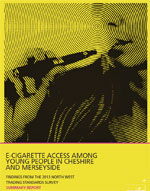On many high streets in the UK, ‘Vaping Shops’ are opening up with claims that they help to stop smoking; despite there being absolutely zero evidence that switching to ‘vaping’ (smoking E-Cigarettes) helps people stop. Majority of studies show that people are merely switching from tobacco based smoking to liquid nicotine, both of which are highly additive.
 In effect, people are merely swapping one addiction for another – encouraged by the Government and the NHS on the grounds that it is healthier to smoke E-Cigarettes rather than smoke tobacco based cigarettes!
In effect, people are merely swapping one addiction for another – encouraged by the Government and the NHS on the grounds that it is healthier to smoke E-Cigarettes rather than smoke tobacco based cigarettes!
Unionsafety made this argument several years ago and as far back as 2007 and was criticised by members of the E-Cigarette industry body of the UK’s largest growing consumer goods sector.
Ironically, the industry no longer markets it addictive product as purely an alternative to smoking; but targets the ‘fun’ element of doing so and actually encourages the uptake of smoking E-Cigs by anyone, whether or not they are an existing smoker!
The E-Cigs industry is worth £1bn, and is the UK’s largest growing consumer goods sector. This mirrors that of the tobacco industry in its early years and it is no wonder the same type of aggressive dismissal of scientific facts about the chemicals in liquid nicotine and those produced during the heating process and in the ‘flavouring’ and ‘vapour’ (smoke) given off and inhaled by those nearby (secondary smoking); are employed against anyone criticising their claims that it is harmless and helps people stop smoking!
They originally claimed that the smoke from e-cigarettes was merely water vapour, but that was quickly dispelled by scientific research into the chemical compounds in the product and those produced during the heating of the liquid nicotine, and in the smoke given off. The two main chemicals, propylene glycol, and glycerine are commonly used across the world and considered safe to use in both the US and the EU, for the use in which it has been produced. For example, propylene glycol is used to make anti-freeze. Both are used in so-called ‘beauty products’ and to provide sweetness in food and as an alternative to sugar.
However, neither have been given the go-ahead in terms of safety to be inhaled directly into the lungs!
Flavourings too, and added to the product, contain dangerous chemicals; and even carcinogenic compounds. A BBC programme investigated this and again, all myths put out by the E-Cigs industry that their flavourings were ‘fun and harmless’ were dispelled by the facts! Again, none are seen as safe to be inhaled directly into the lungs!
 Now, adverts on buses and at bus stops and railway stations, infer that smoking E-Cigs i.e. ‘vaping’ is actually a fun and healthy thing to do, in the same way that adverts for cigarettes right up until the 1970s claimed that smoking tobacco had a health benefit!
Now, adverts on buses and at bus stops and railway stations, infer that smoking E-Cigs i.e. ‘vaping’ is actually a fun and healthy thing to do, in the same way that adverts for cigarettes right up until the 1970s claimed that smoking tobacco had a health benefit!
Yet, the evidence was eventually allowed to be publicised what everyone already knew; inhaling tobacco smoke causes lung cancer. throat cancer, stomach cancer and even cancer of the tongue.
Whilst it is indeed true that there are far fewer chemicals inhaled into the lungs when using e-cigarettes, than is when using manufactured cigarettes; rolling your own, means fewer cancer-causing chemicals are present.
Therefore, the actual benefits from e-cigarette smoking are determined upon whether or not you roll your own. That said; it is a fact that using e-cigarettes removes the majority of the 4000 chemicals inhaled when using conventional tobacco products.
However, examining what actually is in electronic cigarettes, tells a whole different story.
With newer chemicals never before inhaled, (Propylene Glycol for example) being present in the liquid nicotine being heated up; and ever present in the ‘vapour’ being breathed in by the user and those in the vicinity of the huge cloud of smoke being produced on exhalation, the impact upon our health is unknown, despite common sense telling us that if inhaling nicotine, tobacco and the 4000 chemicals in conventional cigarettes is harmful, then inhaling any form of chemicals and nicotine; is indeed unhealthy. Worse still part of the ‘in-thing’ for those using electronic cigarettes is to produce the biggest cloud of smoke possible which means a greater amount of chemicals present!
Ironically for an industry that maintains it’s healthy credentials based on there being far fewer chemicals in e-cigarettes, the introduction of ‘flavouring’ to the e-liquid; has meant that such chemicals are as never before, being inhaled direct into people’s lungs!
 Evidence of children using e-cigarettes has been around ever since e-cigarettes started to be sold around 2007 and increased when high street shops and supermarkets sold them and labeled them as a ‘health product’ or ‘healthy alternative to smoking cigarettes’ and manufacturers deliberately designed ‘glamorous’ packaging, in the same way as the tobacco industry did; but this time aimed at children!
Evidence of children using e-cigarettes has been around ever since e-cigarettes started to be sold around 2007 and increased when high street shops and supermarkets sold them and labeled them as a ‘health product’ or ‘healthy alternative to smoking cigarettes’ and manufacturers deliberately designed ‘glamorous’ packaging, in the same way as the tobacco industry did; but this time aimed at children!
Furthermore, the use of sweet flavourings such as Mango and Apple Orchard, are clearly marketed at children.
Indeed, ‘vaping’ is NOT marketed as a way of quitting smoking as it originally tried to do, but as a ‘fun thing’ and the ‘in-thing’ to do. Staffing the shops with mostly young people is also part of the strategy of marketing the product to children.
In 2013, research results into E-Cigarettes by John Moores University in Liverpool showed that:
“One in eight (12.7%) young people reported having accessed e-cigarettes. Prevalence ranged from 10.4% in 14 year olds to 14.7% in 16 year olds, with no differences by gender or deprivation. E-cigarette access was strongly associated with tobacco smoking.”
The report recommends a number of actions to deter young people from using e-cigarettes, arguing that the use of tobacco products should be minimised, and that smoking whether from tobacco products or by using liquid nicotine products; needs to be tackled if society is to attain true health equality.
The main recommendation:
 “Information should be developed for young people on the potential risks and harms associated with e-cigarette use; the chemical content of e-cigarettes; e-cigarette testing, including safety and quality issues; and current and proposed regulations surrounding their sale and use.”
“Information should be developed for young people on the potential risks and harms associated with e-cigarette use; the chemical content of e-cigarettes; e-cigarette testing, including safety and quality issues; and current and proposed regulations surrounding their sale and use.”
In reality the direct opposite is happening as the growth of E-Cigarettes outlets grows more and more, and predominantly staffed by young people and adverts for ‘vaping’ appears on more and more public places and public transport vehicles.
The presence of e-cigarettes on open shelves in supermarkets health and beauty aisle sends the false message that they are safe to use and in fact give the user an image of beauty and health.
Based on Trading Standards North West surveys, the evidence is probably only reflecting the tip of the ice-berg, given that local authorities have systematically cut their trading standards and environmental health departments to the bone.
 The full document entitled “E-Cigarette Access Among Young People In Cheshire And Merseyside” can be downloaded from the Unionsafety E-Library.
The full document entitled “E-Cigarette Access Among Young People In Cheshire And Merseyside” can be downloaded from the Unionsafety E-Library.
E-cigarettes selling techniques, include the use of brightly coloured packaging and advertising. Now a controversial brand accused of targeting children in the United States, are now sold in the health section of Sainsbury’s!
The Mail-on-line recently published an article providing some evidence of marketing of the product to children:
“Among products on sale are sweet-flavoured e-liquids including Mango and Apple Orchard, made by Juul.
The US firm, worth £30 billion and 35 per cent owned by tobacco giant Altria Group, has previously attracted controversy over its marketing tactics, including a 2015 advert featuring a young woman in a crop top posing with a Juul. The firm stresses its products are for over-18s only.
Just today (25th July), in the USA their House Committee on Oversight and Reform’s Economic and Consumer Policy subcommittee examination of Juul’s marketing and health claims in a two-part hearing on Wednesday and Thursday entitled “Examining Juul’s Role in the Youth Nicotine Epidemic.” completes.
This after a US federal survey found nearly 21% — or 3 million — U.S. high school students vaped last year. Some, including former Food and Drug Administration Commissioner Scott Gottlieb, blame the surge in teen e-cigarette use on Juul, which makes the market-leading product.
British vaping firms are also openly marketing products at children with brightly coloured packaging and sweet flavours.
The Mail on Sunday found dozens of brands for sale with vibrant packaging which look almost identical to fizzy drinks and sweets – despite advertising rules that ban them from targeting children.
Flavours sold by IVG Premium E-Liquids, based in Preston, include Butterscotch Custard and Bubblegum Custard. One advertisement on IVG’s Instagram page features its tobacco products in a classroom.
Fruit Bandits, distributed by a firm in the West Midlands, markets its Bubblegum Billions with cartoon fruit characters.
Both IVG and Fruit Bandits claim their products were not designed to appeal to children.”
It is hard to believe for one moment with these marketing activities, that children are NOT being targeted!
Source: CNBC / BBC News / Daily Mail / unionsafety